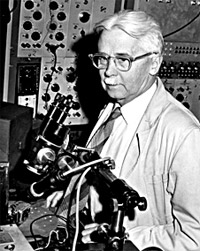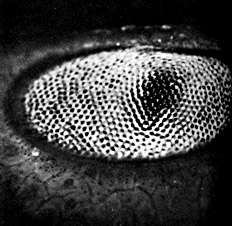Pioneering the Application of Mathematics and Computers to Investigate the Neurophysiology of Vision

Hartline, Keffer
Courtesy of The Rockefeller Archive Center
The eyes of a horseshoe crab (Limulus polyphemus) have large light-sensing cells, and the animal's long optic ganglion-the bundle of nerve cells carrying visual signals to the brain-is easy to dissect. In experiments with Limulus, H. Keffer Hartline (1903-1983) laid the foundation for understanding how the brain processes visual information. He was the first, in 1932 with Clarence Graham, to record the electrical activity of a single optic nerve fiber. Over the next decades he studied how these nerve fibers interact with each other, work that led him to discover lateral inhibition in the retina-the visual process that sharpens the perception of the borders of objects and thus enhances contrast. For these and other findings that opened the way to a quantitative, biophysical understanding of how sensory receptor cells function, Hartline was awarded the Nobel Prize in 1967, shared with Ragnar Granit (1900-1991) and George Wald (1906-1997).
In the 1920s, when Hartline became interested in how organisms sense light, little was known about the retina, the part of the eye where cells convert light into neural signals that are transmitted to the brain. He did his first research, on phototrophic organisms, during a summer at the Marine Biological Laboratory in Woods Hole while he was an undergraduate. Soon after, as a medical student at Johns Hopkins, Hartline had access to a relatively new and temperamental instrument-a string galvanometer-which he used in groundbreaking research recording action potentials from the retinas of several species, including humans. This early research success led Hartline to pursue training in physics rather than practicing medicine, and in 1931 he accepted a position at the Eldridge Reeves Johnson Foundation at the University of Pennsylvania, the nation's research hub for the burgeoning field of biophysics. There he pioneered the study of single optic nerve fibers from vertebrates as well as Limulus, work that led him to map the activity of the visual receptive field. With colleagues, he recorded intracellular generator potentials for the first time, the graded responses of sensory cells to a stimulus. Extending his detailed studies of individual photoreceptors, Hartline investigated how these cells are interconnected, and how visual information is integrated. Hartline discovered lateral inhibition while at the Johnson Foundation. Later, at Rockefeller, he and Floyd Ratliff developed the Hartline-Ratliff equations-the first mathematical description of a neural network based on electrophysiological measurements.

The compound eye of the horseshoe crab (Limulus), about twenty time natural size, used by H. Keffer Hartline in studies of the neurophysiology of vision.
Throughout his career Hartline's research depended on advances in instrumentation and techniques, including the oscilloscope, microdissection, and micropipette electrodes. He was known as a skilled inventor, and worked closely with instrument-makers and electronics engineers. In 1962 Hartline introduced computing to neurophysiologic research when he purchased the Rockefeller Institute's first computer, a Control Data Corporation 160-A, for data analysis.
Haldan Keffer Hartline received the BS from Lafayette College (1923) and the MD from the Johns Hopkins School of Medicine (1927). For the next two years he remained at Johns Hopkins as a National Research Council Fellow taking courses in physics. In 1929 he went to Germany on an Eldridge Reeves Johnson Traveling Fellowship to study physics with Werner Heisenberg's group in Leipzig, and with Arnold Sommerfeld in Munich. In 1931 Detlev Bronk, then director of the Eldridge Reeves Johnson Foundation at the University of Pennsylvania, recruited Hartline for a position in medical physics. Hartline's career followed that of Bronk's thereafter. Aside from a year (1940-1941) at Cornell Medical College, he remained at the Johnson Foundation until 1949, when Bronk became president of Johns Hopkins University and offered Hartline a position as professor of biophysics and chairman of a new biophysics department. In 1953, when Bronk became president of the Rockefeller Institute, Hartline moved too, and became head of the laboratory of biophysics. He remained at Rockefeller until retiring in 1974. In addition to the Nobel Prize (1967), Hartline was awarded the William H. Howell Award (Physiology, 1927), the Howard Crosby Warren Medal (Society of Experimental Psychologists,1948), the Albert A. Michelson Award (Case Institute of Technology, 1964), and the Lighthouse Award (1969). He was elected to the U.S. National Academy of Sciences, and was a foreign Member of the Royal Society (London), and held memberships in the American Academy of Arts and Sciences, the American Philosophical Society, the American Physiological Society, the Optical Society of America, and the Biophysical Society.
Selected Publications
Hartline HK and Graham CH. Nerve impulses from single receptors in the eye. J Cell Comp Physiol, 1932, 1: 277-295
Hartline HK. The effects of spatial summation in the retina on the excitation of the fibers of the optic nerve. Am J Physiol, 1940, 130: 700-711
Hartline HK. Inhibition of activity of visual receptors by illuminating nearby retinal areas in the Limulus eye. Fed Proc, 1949, 8: 69
Hartline HK, Wagner HG, and Ratcliff F. Inhibition in the eye of Limulus. J Gen Physiol, 1956, 39: 651-673
http://jgp.rupress.org/cgi/reprint/39/5/651
Hartline HK and Ratliff F. Spatial summation of inhibitory influences in the eye of Limulus, and the mutual interaction of receptor units. J Gen Physiol, 1958, 41: 1049-1066
http://jgp.rupress.org/cgi/reprint/41/5/1049
Hartline HK. Receptor mechanisms and the integration of sensory information in the eye. Rev Modern Physics, 1959, 31: 515-523
Ratliff F and Hartline HK. The responses of limulus optic nerve fibers to patterns of illumination on the receptor mosaic. J Gen Physiol, 1959, 42: 1241-1255
http://jgp.rupress.org/cgi/reprint/42/6/1241
Hartline HK. Studies on Excitation and Inhibition in the Retina. A Collection of Papers from the Laboratories of H. Keffer Hartline. Ratliff F, ed. New York: Rockefeller Univ Press, 1974
http://books.google.com/books?id=Pn8OAAAAQAAJ&dq=keffer+hartline&printsec=frontcover&source=bl&ots=SumYl5JLrp&sig=F5kEuE7-qzv_H7jZnWBlWOSk53s&hl=en&ei=GsoWSteMFaXhtgfbjrDuDA&sa=X&oi=book_result&ct=result&resnum=9#PPR7,M1
Further Reading
Ratliff F. Haldan Keffer Hartline (December 22, 1903-March 18, 1983): A Biographical Memoir. Washington, DC: U.S. National Academy of Sciences, 1990, 59: 196-213
Miller WH, Ratliff F, and Hartline HK, How cells receive stimuli. Scientific American, 1961, 215(3): 222-238
Links
The Nobel Prize in Physiology or Medicine, 1967
http://nobelprize.org/nobel_prizes/medicine/laureates/1967/index.html
The Horseshoe Crab: Vision
http://www.mbl.edu/marine_org/images/animals/Limulus/vision/index.html
